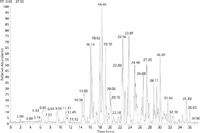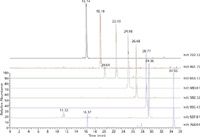Analysis of Bovine Serum Albumin (BSA) Digest on a Thermo Scientific Accucore 150-C18, Nanol Column
The Application Notebook
Thermo Scientific
This application note demonstrates the analysis of trypsindigested bovine serum albumin (BSA) using a Thermo Scientific Accucore 150-C18 (150 Å pore diameter) nanoLC column.
Accucore™ HPLC columns use Core Enhanced Technology™ to facilitate fast and high efficiency separations. Accucore 150-C18 has been further optimized for the analysis of biomolecules and protein digests by extending the pore size to 150 Å.
The increased pore diameter enables larger peptide fragments to diffuse into the particle and interact with the stationary phase more effectively, resulting in high resolution of these fragments.
Herein, we demonstrate the excellent performance of Accucore 150C18 nanoLC columns for the separation of digested BSA.
Standard Preparation
A 50 fmol/µL solution of digested BSA was prepared.
Instrumentation, Column, Consumables and Method
Thermo Scientific Dionex UltiMate 3000 RSLCnano LC system, coupled to a Thermo Scientific LTQ-Orbitrap XL mass spectrometer fitted with a Proxeon Nanospray Flex ion source.Accucore 150-C18 2.6 µm, 75 µm i.d. × 150 mm nanoLC column (P/N 16126-157569). Thermo Scientific National Vials and Closures (P/N MSCERT4000-34W).
The sample was loaded directly on the column (1 µL injection volume) through sample loop at gradient start.
Flow rate: 300 nL/min; A: 0.1 % formic acid in water B: 80:20 acetonitrile: water (4–40% B gradient over 30 min; ramp to 95% B over 2 min; hold for 2 min; drop to 4% B over 1 min; hold for 4 min).
Results
Elution of tryptic peptides using the conditions described above was achieved within 36 min (Figure 1). Triplicate analyses showed excellent retention time reproducibility for a set of 12 peptides, with % RSD values below 0.14%. Figure 2 shows the extracted ion chromatograms (EIC) of a subset of the peptides monitored. In all cases the peak shapes were found to be excellent, with minimal peak tailing. A peak capacity value of 200 was obtained (1), showing the high resolution power of Accucore 150-C18 nanoLC columns.

Figure 1: Base peak chromatogram of 50 fmol of digested BSA loaded on an Accucore 150-C18 nanoLC column, 75 µm i.d.ձ50 mm.
Conclusion
Accucore 150-C18 nanoLC columns are an ideal choice for complex proteomic samples, featuring excellent resolution power and runtorun reproducibility.

Figure 2: EIC of a set of eight peptides.
References
(1) X. Wang, Anal. Chem.78(10), 3406–3416 (2006).
Thermo Fisher Scientific
Tudor Road, Manor Park, Runcorn, Cheshire WA7 1TA, UK
tel. +44 (0) 1928 534110

HPLC 2025 Preview: Fundamentally Speaking (Part 1)
May 13th 2025Michael Lämmerhofer from the Institute of Pharmaceutical Sciences, University of Tübingen, Germany, spoke to JFK Huber Lecture Award winner of 2024 Torgny Fornstedt, professor in analytical chemistry and leader of the Fundamental Separation Science Group, Karlstad University, Sweden, about his pioneering work in high performance liquid chromatography (HPLC) with a focus on fundamentals and industrial applications.
Reversed-Phases for LC Deliberately Doped with Positive Charge: Tips and Tricks for Effective Use
May 13th 2025In this month's edition of LC Troubleshooting, Dwight Stoll and his fellow researchers discuss both the benefits (improved peak shape/loading) and challenges (excessive interaction) associated with charge-doped reversed-phase (RP) columns for both analytical and preparative separations.
Determining Ways to Protect Honeybee Colonies with GC–MS
May 13th 2025A study conducted by the Agriculture Research Centre of Giza, Egypt, and Jilin Agricultural University in China, evaluated the efficacy of stinging nettle extract, nettle smoke, and formic acid in the controlling of Varroa mites, a major threat to honeybee colonies, with a focus on mite infestation reduction, honeybee mortality, and biochemical responses. Gas chromatography–mass spectrometry (GC–MS) was used to identify key bioactive compounds in the stinging nettle extract.

.png&w=3840&q=75)

.png&w=3840&q=75)



.png&w=3840&q=75)



.png&w=3840&q=75)



















